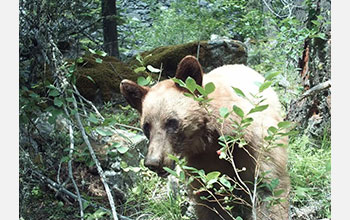Multimedia Gallery
Black bear photographed by trip-camera during TCUP research
This black bear was photographed by a trip-camera set up by researchers from Salish Kootenai College to monitor wild huckleberries. The researchers are studying wild huckleberry phenology with funding from the National Science Foundation's Tribal Colleges and Universities Program.
More about this image
NSF's Tribal Colleges and Universities Program (TCUP) provides awards to institutions that promote high-quality STEM education.
For the tribes they primarily serve, the institutions work to build cultures of science and engineering that could provide substantial economic, societal and environmental benefits. For the students, the colleges provide access to S&E-related vocations such as research careers, nursing and wildlife conservation.
At Salish Kootenai College, located on the Flathead Indian Reservation in Montana, a group of undergraduate researchers are working with Janene Lichtenberg, head of the school's Wildlife and Fisheries Department, to study wild huckleberry phenology, or the ways the plants' surroundings -- including climate, habitat and surrounding flora -- affect them. Using instruments that measure canopy cover and collecting data on pollination by bees and other insects, the team is building a more robust picture of the plants' life cycles.
The research team treks through steep wooded trails to check cameras trained on huckleberries. In addition to being culturally significant to some regional tribes, the wild plants serve as an important food source for deer, birds and other Montana fauna.
A team of TCUP-supported researchers from Aaniiih Nakoda College, located on the Fort Belknap Indian Reservation in Montana, is monitoring water contamination in a stream in the Little Rockies that flows through Mission Canyon and down into the Fort Belknap reservation. Techniques used by a now-defunct mine in its search for gold and silver caused heavy metals to leach into the stream.
Daniel Kinsey, an instructor at the college, studied the stream 20 years ago as a student intern with an environmental surveying team to determine the extent of the leaching. "I plan to collect aquatic macroinvertebrates today and compare the current data with data from 20 years ago," says Kinsey. "I want to see if there has been any change in the macroinvertebrate community in those 20 years."
The team used a sail-like net suspended by two poles to collect sediment they churned up from the bottom of the stream. After flushing the net's contents into specimen containers, the team found life crawling around inside, including larval flies. Those organisms, along with algae, or diatoms, they scraped off nearby rocks, are signs of a healthy ecosystem, Kinsey says.
However, at a second site further upstream, the team found the water contained higher levels of heavy metals, among them iron, which had stained the rocks red. And fewer organisms inhabited the water. Kinsey says the creatures and plants found there tend to be hardier when it comes to surviving in contaminated environments.
To read more about this research, see the NSF Discovery story Building communities of research at tribal college. (Date image taken: 2016; date originally posted to NSF Multimedia Gallery: Aug. 23, 2016)
Credit: Janene Lichtenberg, Salish Kootenai College
Images and other media in the National Science Foundation Multimedia Gallery are available for use in print and electronic material by NSF employees, members of the media, university staff, teachers and the general public. All media in the gallery are intended for personal, educational and nonprofit/non-commercial use only.
Images credited to the National Science Foundation, a federal agency, are in the public domain. The images were created by employees of the United States Government as part of their official duties or prepared by contractors as "works for hire" for NSF. You may freely use NSF-credited images and, at your discretion, credit NSF with a "Courtesy: National Science Foundation" notation.
Additional information about general usage can be found in Conditions.
Also Available:
Download the high-resolution JPG version of the image. (388.0 KB)
Use your mouse to right-click (Mac users may need to Ctrl-click) the link above and choose the option that will save the file or target to your computer.



